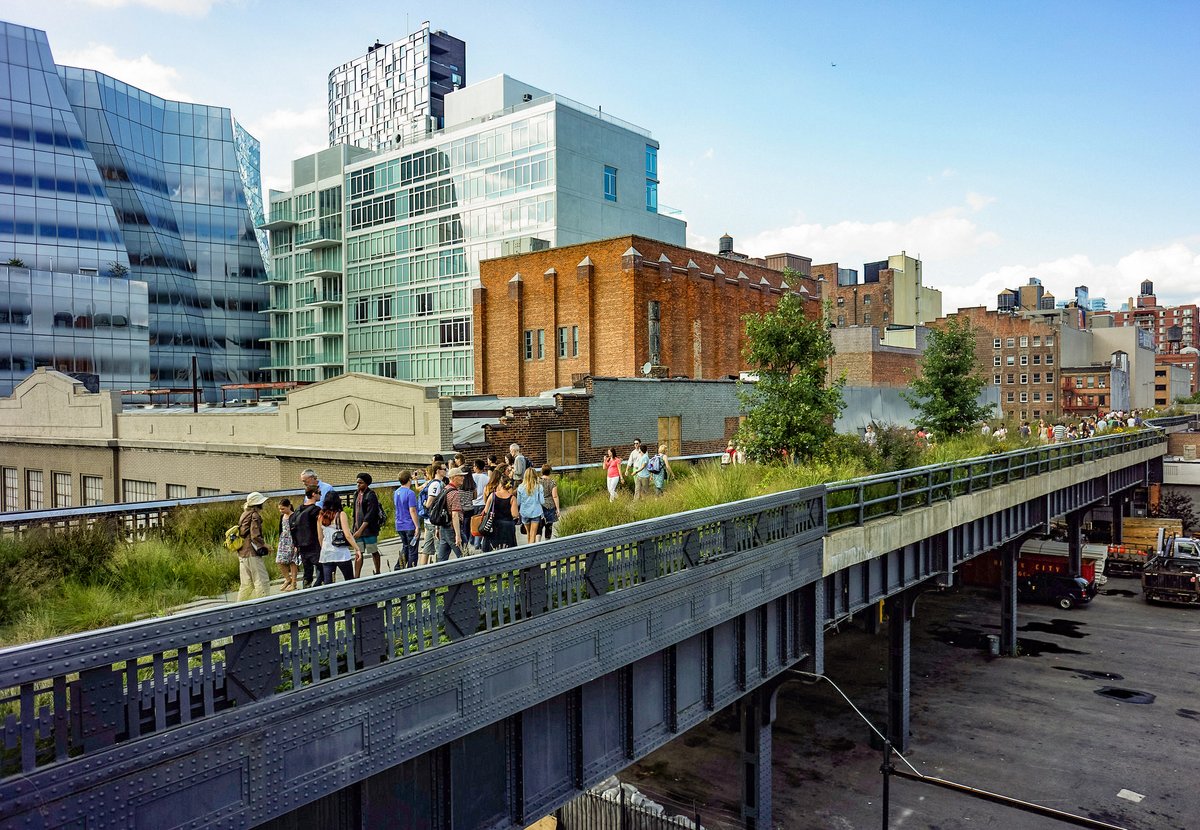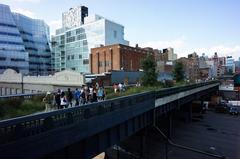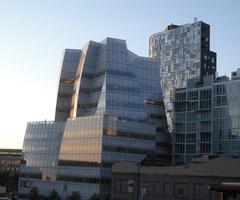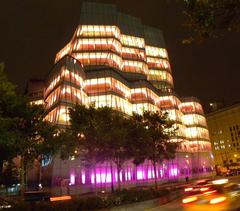
IAC Building New York City: Visiting Hours, Tickets, and Travel Guide
Date: 15/06/2025
Introduction
Located at 555 West 18th Street in the heart of Manhattan’s Chelsea neighborhood, the IAC Building is a striking example of contemporary architecture and a symbol of New York City’s ongoing urban transformation. Designed by world-renowned architect Frank Gehry, and completed in 2007, this structure serves as the global headquarters for InterActiveCorp (IAC). Its undulating, sail-like glass façade pays tribute to the city’s maritime past while reflecting the forward-thinking spirit of the digital media industry. This guide provides a detailed look at the IAC Building’s history, architectural highlights, visitor information—including hours, ticketing, and accessibility—as well as travel tips and recommendations for nearby attractions (study.com; jmhdezhdez.com; Vanity Fair).
Table of Contents
- Introduction
- Historical Background
- Architectural Innovation and Chelsea’s Transformation
- Cultural Significance
- Impact on Community and Creative Industries
- Urban Dialogue and Architectural Discourse
- Integration with Public Spaces and the High Line
- Economic and Social Ripple Effects
- Influence on New York’s Architectural Landscape
- Visiting the IAC Building
- Travel Tips and Nearby Attractions
- Preservation and Legacy
- FAQ
- Further Reading and Sources
- Conclusion
Historical Background
Origins and Commissioning
Commissioned by Barry Diller, chairman and CEO of IAC, the building was conceived to reflect the company’s innovative ethos. Frank Gehry, celebrated for his deconstructivist approach, was chosen to design this headquarters, marking his first completed project in New York City (study.com). Construction began in 2004 and concluded in 2007, during a period of rapid transformation for Chelsea, which was evolving from an industrial area into a center for art, technology, and design (jmhdezhdez.com).
Architectural Context and Urban Setting
Situated at the intersection of West 18th Street and Eleventh Avenue, the IAC Building anchors a corridor that includes the High Line park and a proliferation of art galleries. Gehry’s design harmonizes the neighborhood’s industrial heritage with a vision for digital innovation, using glass to echo the nearby Hudson River and to interact dynamically with the urban landscape.
Design Philosophy and Influences
Taking inspiration from sailing and avant-garde art movements, Gehry designed the building’s façade to resemble a ship’s sails in motion. The use of glass, with a white ceramic frit pattern, marked a departure from his signature metallic surfaces and introduced a play of light and translucency reminiscent of Cubism and Dadaism (study.com).
Construction and Technological Innovation
The building’s envelope is composed of 1,450 uniquely shaped glass curtain wall panels, fabricated using pioneering “cold-warping” techniques. Its reinforced concrete skeleton and angled columns support the twisting, stacked volumes, creating the illusion of two grand stories while housing ten floors of office space (jmhdezhdez.com).
Reception and Cultural Impact
Critics and the public alike have lauded the IAC Building. Nicolai Ouroussoff of The New York Times described it as “the most beautiful building on the West Side.” Its innovative design has influenced corporate architecture and contributed to Chelsea’s reputation as a hub of creativity (study.com).
Architectural Innovation and Chelsea’s Transformation
The IAC Building’s sail-like façade, comprised of over a thousand custom glass panels, set a new standard for architectural experimentation in New York. Gehry’s approach challenged the brick-and-mortar aesthetic of Chelsea, catalyzing a wave of bold design in the neighborhood. Its visual dialogue with the High Line and neighboring landmarks, such as Jean Nouvel’s 100 Eleventh Avenue, underscores its role in the area’s renaissance (Vanity Fair; New York Spaces).
Cultural Significance
Beyond its visual impact, the IAC Building symbolizes the intersection of technology, art, and corporate innovation. Its headquarters function for IAC, a digital media leader, aligns the structure with the ongoing evolution of New York as a global center for tech and creative industries.
Impact on Community and Creative Industries
The IAC Building’s presence has attracted additional investment to Chelsea, spurring growth in technology firms, design studios, and art galleries. Its transparent lobby, equipped with a 118-foot-long video wall, fosters community engagement by making digital art visible from the street (Vanity Fair).
Urban Dialogue and Architectural Discourse
As a key example of Deconstructivism in New York, the building challenges conventional forms and functions, sparking ongoing dialogue among architects and the public. Its glass façade captures and transforms the city’s changing light, making the building an active participant in the city’s rhythms (Vanity Fair).
Integration with Public Spaces and the High Line
The IAC Building’s adjacency to the High Line enhances its visibility and accessibility, creating a synergy between architecture and public space. The sculptural form of the building complements the linear geometry of the park, contributing to the revitalization of Manhattan’s West Side.
Economic and Social Ripple Effects
The building’s completion marked renewed confidence in Chelsea’s potential as a center for business and culture. Property values have risen, and the neighborhood now features luxury residences, boutique hotels, and retail developments. Socially, the building’s lobby and video wall blur boundaries between private corporate space and public art, promoting inclusivity and engagement (New York Spaces).
Influence on New York’s Architectural Landscape
The IAC Building sparked a trend toward more daring commercial architecture in Manhattan, influencing projects such as Jean Nouvel’s 100 Eleventh Avenue and the Hudson Yards towers, and helping to diversify the city’s skyline.
Visiting the IAC Building
Visiting Hours
- Lobby Access: Monday through Friday, 9:00 AM to 6:00 PM. The lobby features a high-definition video wall and is open to the public during standard business hours.
- Exterior Viewing: The building’s façade can be viewed and photographed from public sidewalks and the High Line park at any time. The High Line is open daily from 7:00 AM to 10:00 PM.
Ticketing and Admission
- Tickets: No tickets or admission fees are required to view the exterior or visit the lobby.
- Events: Admission to special events in the lobby (such as exhibitions or conferences) may require an RSVP or invitation.
Accessibility
- Wheelchair Access: The lobby and surrounding public spaces, including sidewalks and entrances to the High Line, are wheelchair accessible.
- Facilities: There are no public restrooms in the IAC Building; nearby parks and Chelsea Market offer facilities.
Events and Guided Tours
- Public Tours: Regular guided tours are not available. However, several architecture-focused walking tours of Chelsea include the IAC Building as a featured stop.
- Special Events: Occasional private events, exhibitions, or product launches are held in the lobby, generally by invitation.
Photography Tips
- Best Vantage Points:
- From the High Line for elevated perspectives
- Across Eleventh Avenue for full-scale views
- Near Chelsea Piers for a westward, river-facing angle
- Lighting: Early morning and late afternoon provide the most dramatic lighting; evening and nighttime reveal the building’s illuminated contours.
Travel Tips and Nearby Attractions
Getting There
- Subway: Take the A, C, E, or L lines to 14th Street or 18th Street stations; walk west toward Eleventh Avenue.
- Buses: Routes run along 10th and 11th Avenues.
- Parking: Street parking is limited; public transportation or rideshare is recommended.
Nearby Attractions
- High Line Park: Elevated linear park with gardens and city views.
- Chelsea Market: Food hall and shopping destination.
- Whitney Museum of American Art: Contemporary art museum near the southern end of the High Line.
- Chelsea Piers: Sports and recreation complex on the Hudson River.
Dining and Accommodations
Chelsea offers diverse dining options (especially in Chelsea Market) and a range of hotels, from boutique to major chains.
Preservation and Legacy
As of June 2025, the IAC Building stands as a celebrated icon of modern architecture and a catalyst for the revitalization of Chelsea. Its continued recognition by architectural organizations helps ensure its preservation for future generations (jmhdezhdez.com).
Frequently Asked Questions (FAQ)
Can I tour the interior of the IAC Building?
No, regular interior tours are not available. Public access is generally limited to the lobby during business hours.
What are the visiting hours?
The lobby is open Monday through Friday, 9:00 AM to 6:00 PM. The exterior can be viewed at any time.
Are tickets required to visit?
No, there are no tickets or fees to view the building from outside or to visit the lobby.
Is the building wheelchair accessible?
Yes, the lobby and surrounding public spaces are accessible.
Are guided tours available?
The building itself does not offer tours, but several Chelsea architecture walking tours feature the IAC Building.
Where are the best spots for photographs?
From the High Line, Eleventh Avenue, and Chelsea Piers.
Visuals and Media
Seek out high-quality images with keywords such as “IAC Building sail-like glass façade Chelsea NYC” and “Lobby video wall at IAC Building.” Interactive maps and virtual tours can further enrich your planning and experience.
Further Reading and Resources
- Frank Gehry’s Influences & Inspirations
- IAC Building, New York by Gehry
- Gehry Slideshow - Vanity Fair
- Official IAC Website
Conclusion
The IAC Building remains a defining piece of New York City’s architectural landscape, fusing Frank Gehry’s visionary design with the vibrant energy of Chelsea. While interior access is limited, its iconic façade and central location make it a must-see for anyone interested in modern architecture or urban renewal. Combine your visit with nearby attractions like the High Line and Chelsea Market for a rewarding Chelsea experience. For the latest updates on events and tours, consult the official IAC website and architectural city guides.
Download the Audiala app for curated travel guides and follow us on social media for more insights into New York’s architectural marvels.
Summary
As of June 2025, the IAC Building stands as a model of architectural innovation and urban revitalization. Frank Gehry’s sail-like design and pioneering construction techniques have left a lasting mark on Chelsea, reinforcing the neighborhood’s status as a creative and technological nucleus. Though interior public access is limited, the lobby and exterior provide ample opportunity to appreciate Gehry’s genius within the city’s dynamic context. Pair your visit with nearby cultural attractions to fully experience Chelsea’s vibrant character. For more details on visiting hours, events, and tours, refer to official sources and city guides, and consider the Audiala app for up-to-date information (study.com; jmhdezhdez.com; Vanity Fair).
Sources
- Frank Gehry’s Influences & Inspirations
- IAC Building, New York by Gehry
- Gehry Slideshow - Vanity Fair

























































































































































































































































































